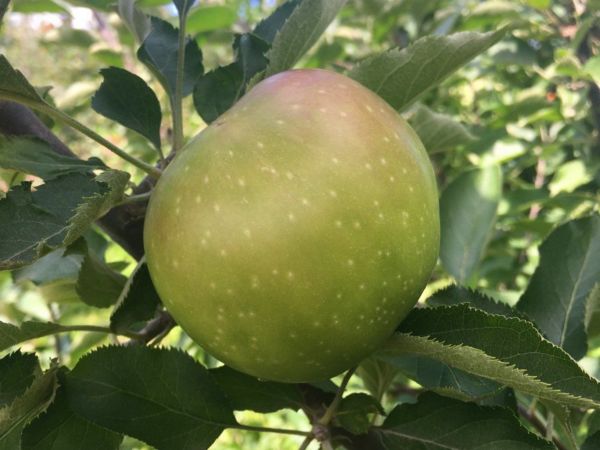An attractive, highly disease-resistant apple, ideal for organic growers.
Rhode Island Greening Apple Scionwood (Spring 2024)
The venerable pie apple native to New England. Also known as Burlington Greening, Ganges, Jersey Greening.
As you might expect from the size of the apple and antiquity of the variety, Rhode Island Greening is both triploid and biennial tending. It will need two diploid pollenizers for full fertility, and it should be thinned well. It is slightly susceptible to scab, cedar-apple rust, and canker, and very susceptible to fireblight. Although slow to produce, this tree is (like its British counterpart Bramley) very long lived.
The large, late-season fruit is greenish yellow with prominent white and russet lenticels. The flesh is also tinged green and yellow, with the firm, chunky texture that American bakers prefer. The flavor is not complex, but it has just the right amout of zing to make an excellent pie. Although this apple does not develop good flavor in Southern climates, it does make an excellent version of one of our favorite Southern recipes: bacon-fried apples. If southern cooking is not your thing, you could try using your Rhode Island Greenings for Danish bacon-fried apples (æbleflæsk), which is the same, but Danish. This apple is also used in cider blending.
Rhode Island Greening is the oldest variety of American origin in production today. The original tree is said to have been grown in Middletown, Rhode Island by a tavern keeper called Green in the 1650s. This original tree became so popular that it died from having too many cuttings made from it.
Volume Pricing
| Quantity | Rhode Island Greening Apple Scion |
|---|---|
| 1 | $12.00 |
| 2-5 | $7.00 |
| 6-10 | $6.00 |
| 11-99 | $5.00 |
| 100+ | $4.00 |
The Fruit
Fruit Type
Category: Apple
Subcategory:
Heirloom
Fruit Uses & Storage
Uses: cider, baking, storage, sauce
Cider classification: sharp
Storage duration: three plus months (approximate, depending on storage conditions)
Fruit Appearance
Skin color: green
Flesh color: off-white
Fruit Origins
Parentage: unknown
Origin: Rhode Island
Introduced in: 1650s
Introduced by: Mr. Green
The Environment
Calendar & Geography
USDA zones: 5 - 7
Chill hours: Not yet determined
Ripening date: Nov 03 (approximate, in New York State) + 49 days after McIntosh
Diseases & Pests
glossary
Apple Scab: Susceptible
Cedar-Apple Rust: Susceptible
Fireblight: Very Susceptible
Perennial Canker: Susceptible
Pollination
Pollination Factors
glossary
Bloom group: 3
Is it self-fertile? N
Is it fertile? N
Ploidy: Triploid
Pollination Partners
This table shows the first few results from a full search for pollenizers of Rhode Island Greening Apple. Please see our Pollenizer Search to run other queries and read how the application uses various factors. Also read more about fruit tree pollination.
| Tree | Currently in Stock |
|---|---|
| Florina Apple | 0 |
| Porter's Perfection Apple | 0 |
| Spitzenburg Esopus Apple | 0 |
| Binet Rouge Apple | 0 |
| Rubinette Apple | 0 |
| Virginia Crab Apple | 0 |
| Bramtot Apple | 0 |
| Mother Apple | 0 |
| Repinaldo Do Liebana Apple | 0 |
| Muscadet De Dieppe Apple | 0 |
| Kingston Black Apple | 0 |
See all pollination matches for Rhode Island Greening Apple
Featured Products
A few things we're loving right now...
A full-flavored, freestone white peach.
One of America's oldest apples, good for storage, baking, and cider.
A widely-grown, large, yellow-fleshed nectarine.
























